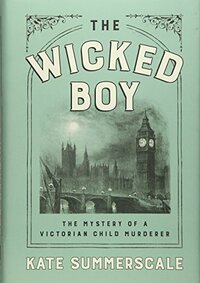Take a photo of a barcode or cover
This book started off as one thing, and ended as something completely different. And I mean this in the best way possible. Summerscale begins the book by catapulting the reader into the thick of the story, with no background material or "summary" of what the crime was (the prologue is only one paragraph). I thought this was a very refreshing take on historical true crime novels, as most begin by laying everything out before you even get past chapter 1. I enjoyed this style of unfolding the story exactly how the Summerscale would have found out about the details in her research (as well as how the public would have found out in the 1890s). Although meandering storylines were introduced later on, the beginning pretty much stuck to a straight line narrative, something that I appreciated for this type of retelling. It even made it feel more fast-paced and tense.
While the first part focused on the Robert Coombes' crime, the second part does a complete 180 and focuses on his life after the crime and how he became a soldier, a respected citizen, and even a guardian to a young boy, saving him from harm. The book ends with this redemption story and Summerscale attempts to analyze Coombes' actions as a boy, summarizing the tale, and comparing it to how he ended up. The result is a Victorian murder mystery/psychological analysis/biography/heart warming story that weaves together into a very enjoyable read.
While the first part focused on the Robert Coombes' crime, the second part does a complete 180 and focuses on his life after the crime and how he became a soldier, a respected citizen, and even a guardian to a young boy, saving him from harm. The book ends with this redemption story and Summerscale attempts to analyze Coombes' actions as a boy, summarizing the tale, and comparing it to how he ended up. The result is a Victorian murder mystery/psychological analysis/biography/heart warming story that weaves together into a very enjoyable read.
adventurous
informative
mysterious
reflective
sad
medium-paced
Not quite as amazing as The Suspicions of Mr Whicher, but still fascinating, engaging, and strangely moving.
adventurous
dark
informative
reflective
sad
slow-paced
My second Summerscale book after The Suspicions of Mr Whicher. This is fairly similar - explaining a crime and it’s aftermath but very different circumstances. It’s hard to know why the murder occurred but it does seem clear from the ending that it wasn’t as sensational as initially believed. It’s amazing how much research and time went into building the story.
Fascinating, well-researched and moving account of a crime, the perpetrators and victim.
One night in July 1895 Robert Coombes murdered his mother. A week later his aunt became suspicious and broke into the family home to discover the dead body of her sister-in-law in the front bedroom. Her thirteen and twelve year old nephews, Robert and Nathaniel were responsible. Nathaniel later testified to his brother's role in the murder and was never charged, while Robert was deemed guilty but insane and sent to Broadmoor. In 1912 he was released into the care of the 'Sally Army', and in 1914 emigrated to Australia. Nathaniel had joined the Merchant Navy then the Royal Navy as a stoker. He was transferred to the Australian Navy about the same time Robert left England for Sydney. As soon as WW1 was declared, Robert, who'd learnt to tailor and garden in Broadmoor, as well as becoming an accomplished musician and cricketer, joined the 13th Battalion of the 4 th Brigade, Australian Imperial Forces. After a period of training in Aus, he travelled to Egypt, became part of the Battalion band, and a stretcher barer, and was sent to Gallipoli as part of the Anzac forces. He was one of only 7 stretcher barers to survive from the 13th to survive the six months. Sent back to Egypt, he join a sanitation corps, and continued to play in the band, transferring to the 45th battalion. They were sent to France, and Coombes saw service on the Somme, and Paschendaele, among other battles, and finally returned to Australian in late 1914. Again, he was among the small number of men who'd originally joined up and survived the entire war. Of the original 32,000 men of the AIF, only 7.000 survived. He was awarded several medals, was injured and commended by his commanding officers.
Meanwhile, his brother rose through the stoker ranks, chased German ships around the Atlantic and North Sea, and missed the Battle of Jutland because of a collision between his ship and another that sent them into dock for repairs. After the war they settled down in New South Wales, about 300 miles apart, which is virtually next door in Australian terms. Nathaniel eventually married at the age of 45.
Robert moved to Nana Glen, rented a piece of land, built a shack and worked a garden, wile keeping a few milk cows. He took in a young boy who was a neighbour and being abused by his step-father. He was respected in life and remembered fondly by friends and neighbours in death.
One night in July 1895 Robert Coombes murdered his mother. A week later his aunt became suspicious and broke into the family home to discover the dead body of her sister-in-law in the front bedroom. Her thirteen and twelve year old nephews, Robert and Nathaniel were responsible. Nathaniel later testified to his brother's role in the murder and was never charged, while Robert was deemed guilty but insane and sent to Broadmoor. In 1912 he was released into the care of the 'Sally Army', and in 1914 emigrated to Australia. Nathaniel had joined the Merchant Navy then the Royal Navy as a stoker. He was transferred to the Australian Navy about the same time Robert left England for Sydney. As soon as WW1 was declared, Robert, who'd learnt to tailor and garden in Broadmoor, as well as becoming an accomplished musician and cricketer, joined the 13th Battalion of the 4 th Brigade, Australian Imperial Forces. After a period of training in Aus, he travelled to Egypt, became part of the Battalion band, and a stretcher barer, and was sent to Gallipoli as part of the Anzac forces. He was one of only 7 stretcher barers to survive from the 13th to survive the six months. Sent back to Egypt, he join a sanitation corps, and continued to play in the band, transferring to the 45th battalion. They were sent to France, and Coombes saw service on the Somme, and Paschendaele, among other battles, and finally returned to Australian in late 1914. Again, he was among the small number of men who'd originally joined up and survived the entire war. Of the original 32,000 men of the AIF, only 7.000 survived. He was awarded several medals, was injured and commended by his commanding officers.
Meanwhile, his brother rose through the stoker ranks, chased German ships around the Atlantic and North Sea, and missed the Battle of Jutland because of a collision between his ship and another that sent them into dock for repairs. After the war they settled down in New South Wales, about 300 miles apart, which is virtually next door in Australian terms. Nathaniel eventually married at the age of 45.
Robert moved to Nana Glen, rented a piece of land, built a shack and worked a garden, wile keeping a few milk cows. He took in a young boy who was a neighbour and being abused by his step-father. He was respected in life and remembered fondly by friends and neighbours in death.
Well-researched history hinging on a boy murdering his mother, encompassing asylums, court process, early studies in pathology. Just not enough story.
challenging
dark
informative
slow-paced
I love historical fiction. I love true crime. I thought this would combine two things I love- history and true crime. I didn't love this book. This felt more like a biography that included a small section of crime. I understand it is likely hard to write an entire book about a crime that took place so long ago but it made this book difficult to get through.
Starts strong, but the last third of the book is missing the luscious details that make the first part so engaging. I understand that it was difficult to track down some of the details on this part of Coombes life, but then why bother?





